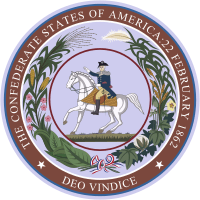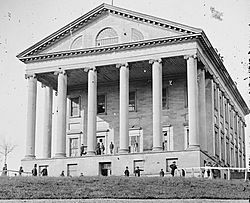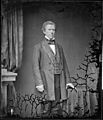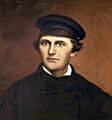Congress of the Confederate States facts for kids
Quick facts for kids Confederate States Congress |
|
|---|---|
 |
|
| Type | |
| Type | |
| Houses | Senate, House of Representatives |
| Leadership | |
|
Robert Hunter
|
|
|
President pro tempore ad interim
|
|
|
Thomas Bocock
|
|
|
William Parish Chilton
|
|
| Seats | 135 26 Senators 109 Representatives |
| Meeting place | |
 State Capitol Richmond, Virginia |
|
The Congress of the Confederate States was the main law-making group for the Confederate States of America. This government body existed during the American Civil War, from 1861 to 1865.
Just like the United States Congress, the Confederate Congress had two main parts. The first part was the Senate, also known as the upper house. Each state sent two senators to the Senate. These senators were chosen by their state's own law-making groups. The second part was the House of Representatives, or the lower house. Its members were chosen by the citizens of each state through elections.
Contents
How Many Congresses Were There?
The Confederate States had three different congresses during its short history.
The Provisional Congress (1861-1862)
The first meeting was called the Provisional Congress. It started on February 4, 1861, in Montgomery, Alabama. Representatives were chosen by special meetings in each state that decided to leave the United States. This first congress finished its work on February 17, 1862.
The First Congress (1862-1864)
The First Congress began its first meeting on February 18, 1862. It held four different meetings, called sessions. This congress ended exactly two years later, on February 18, 1864. It ended sine die, which means without setting a date for another meeting.
The Second Congress (1864-1865)
The Second Congress met for two sessions. Its last meeting was on March 18, 1865. This was very close to the end of the Civil War.
What Did the Confederate Congress Do?
One of the first things the Confederate Congress did was to keep all the laws of the United States that did not go against the new Confederate States Constitution.
The Confederate Constitution
The Confederate States Constitution was officially adopted on March 11, 1861. It was very similar to the U.S. Constitution. However, there were a few important differences. For example, the Confederate President, Jefferson Davis, had a special power called a line-item veto. This meant he could reject specific parts of a bill without rejecting the whole thing.
Also, the Confederate President could only serve one six-year term and could not be re-elected. Members of the President's cabinet (his top advisors) could also attend Congress meetings. They could speak but could not vote on laws.
Challenges for the Congress
The central government of the Confederacy, including the President and Congress, had limited power. They could not make laws that were stronger than the laws of individual Confederate states. The Confederacy also never created a Supreme Court. They could not agree on how it should work.
Because the government was limited, it was hard for them to raise enough money. States sometimes refused to send their soldiers if they felt they were needed more in their own state. The Congress also struggled to control inflation, which is when prices go up very quickly. This led to food riots in some Southern cities, including Richmond, Virginia, the capital.
While the United States Congress was making many new laws, the Confederate Congress was mostly trying to keep the Confederacy running. They passed important laws to help the war effort.
Key Laws and Debates
In 1862, the Confederate Congress passed the first military draft law. This meant men had to join the army. They also approved allowing black men to serve as soldiers in March 1865. This idea had been discussed for a long time, especially as it became clear the South might lose the war.
Around 1864, the Confederate Congress faced a difficult time. The army desperately needed more soldiers. Some members of Congress even suggested that they should join the military and fight. Another idea was to excuse men over 50 from military service, which included most members of Congress. Some wanted Congress to leave Richmond and find a safer place as the Union Army got closer. While they debated, Union forces were closing in on Richmond. At the same time, Sherman's March to the Sea was moving towards Atlanta, Georgia.
Images for kids
-
George W. Randolph, Sec. of War for national conscription















